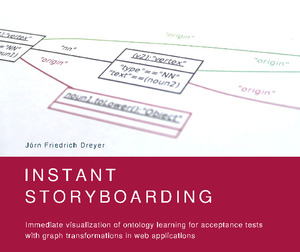| dc.date.accessioned | 2015-11-09T08:27:25Z | |
| dc.date.available | 2015-11-09T08:27:25Z | |
| dc.date.issued | 2015-11-09 | |
| dc.identifier.isbn | 1-51524-095-2 | |
| dc.identifier.isbn | 978-1-51524-095-2 | |
| dc.identifier.uri | urn:nbn:de:hebis:34-2015110949301 | |
| dc.identifier.uri | http://hdl.handle.net/123456789/2015110949301 | |
| dc.language.iso | eng | |
| dc.rights | Urheberrechtlich geschützt | |
| dc.rights.uri | https://rightsstatements.org/page/InC/1.0/ | |
| dc.subject | software engineering | eng |
| dc.subject | instant storyboarding | eng |
| dc.subject | online storyboarding | eng |
| dc.subject | fujaba | eng |
| dc.subject | natural language processing | eng |
| dc.subject | graph transformations | eng |
| dc.subject | visualization | eng |
| dc.subject | ontology learning | eng |
| dc.subject | acceptance tests | eng |
| dc.subject | web applications | eng |
| dc.subject.ddc | 004 | |
| dc.title | Instant Storyboarding | eng |
| dc.type | Dissertation | |
| dcterms.abstract | This thesis aims at empowering software customers with a tool to build software tests them selves, based on a gradual refinement of natural language scenarios into executable visual test models. The process is divided in five steps:
1. First, a natural language parser is used to extract a graph of grammatical relations from the textual scenario descriptions.
2. The resulting graph is transformed into an informal story pattern by interpreting structurization rules based on Fujaba Story Diagrams.
3. While the informal story pattern can already be used by humans the diagram still lacks technical details, especially type information. To add them, a recommender based framework uses web sites and other resources to generate formalization rules.
4. As a preparation for the code generation the classes derived for formal story patterns are aligned across all story steps, substituting a class diagram.
5. Finally, a headless version of Fujaba is used to generate an executable JUnit test.
The graph transformations used in the browser application are specified in a textual domain specific language and visualized as story pattern. Last but not least, only the heavyweight parsing (step 1) and code generation (step 5) are executed on the server side. All graph transformation steps (2, 3 and 4) are executed in the browser by an interpreter written in JavaScript/GWT.
This result paves the way for online collaboration between global teams of software customers, IT business analysts and software developers. | eng |
| dcterms.accessRights | open access | |
| dcterms.alternative | Immediate visualization of ontology learning for acceptance tests with graph transformations in web applications | eng |
| dcterms.creator | Dreyer, Jörn Friedrich | |
| dc.contributor.corporatename | Kassel, Universität Kassel, Fachbereich Elektrotechnik / Informatik | |
| dc.contributor.referee | Zündorf, Albert (Prof. Dr.) | |
| dc.contributor.referee | Van Gorp, Pieter (Prof. UD) | |
| dc.subject.ccs | I.2.6 | |
| dc.subject.ccs | I.2.7 | |
| dc.subject.ccs | H.3.5 | |
| dc.subject.ccs | D.1.7 | |
| dc.subject.swd | Software Engineering | ger |
| dc.subject.swd | Ontologie Wissensverarbeitung | ger |
| dc.date.examination | 2014-11-11 | |

